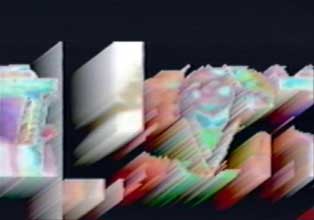With a background in film scoring, Ralske became attuned to the subtle interaction of music and image - the myriad possibilities of ways sound and image can inflect each other's tone and meaning. Ralske works with nato.0+55, which he rewrites and supplements as the need arises. Using nato.0+55, digital sound and moving images can be edited in real time. It can access information from any digital source and read it as if it were sound or image. The same digital strings can control several aspects of a composition. It is possible, for example, to write the colour of an image and the interval of a note simultaneously (for nato.0+55 see  'Nezvanova').
'Nezvanova').
Ralske describes his current video work as an inversion of his previous role: 'reverse film scoring', creating image to match sound, instead of the other way around. In a liquid, organic manner, small fragments of archival footage are processed almost beyond recognition, then blended with images generated by purely digital means. The resulting quasi-narrative has the self-referential logic of dream or inner monologue.
'Ursonate.02' is a performance, a live improvisation in sound and image. The first 'Ursonate' was, of course, composed by Kurt Schwitters in 1932, a phonatory score with no linguistic meaning. The 'Ursonate' is a composition of syllables connected via tone and rhythm, rather than language. His title suggests that Ralske approaches the elements he uses in his improvisations in a similar way: as tonal and pictorial forms, that is, with no intrinsic meaning. Primitive forms, with which he seeks to create a sensory experience rather than a narrative. Schwitters's 'Ursonate' is in four parts, four movements, which - except for their written-out notes and syllables - contain only bare indications of tempo and very rough instructions for the performer. A performance is, therefore, subject to very free interpretation.
Ralske makes his artistic selection at several levels. The most important of these are the music and the image that is to serve as the starting point of the treatment. His music is very pure and direct, spare but emotional. The images from which he sets out continue to be vaguely recognizable, but they do not tell a story. We see walking legs, faces, a dog sniffing about. They could just as easily be other, equally everyday images. Both the music and the images remain open and complement each other, as it were. Ralske's most important aesthetic decisions seem to be matters of software configuration and the programming of the constantly shifting relations between the image and the sound, which is precisely what nato.0+55 is particularly good at. And also, analogously to Schwitters, precisely the source of his freedom as a performer. It is impossible to tell during a performance - certainly for someone with no experience of programming - which aspect of the sound is influencing which aspect of the image (and vice versa), although we feel that the answer is hanging in the air in a pleasantly seductive way, and we almost catch what is happening.
– Klaas Kuitenbrouwer
